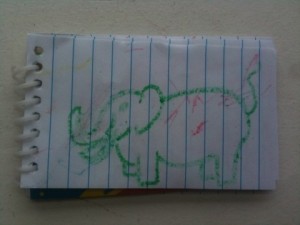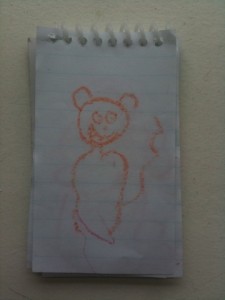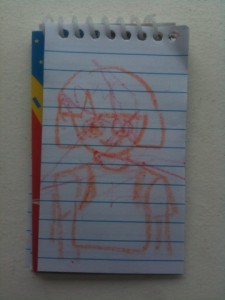
So, in this week’s New Yorker, Adam Gopnik learns how to draw. An art-historian by training, he bumps into a neo-realist (or “traditionalist realist revivalist” or something) artist at a dinner party and starts studying the basic art of drawing with him. At first, it does not go too well:
Why was I unable to do something so painfully simple? Whatever sense of professional competence we feel in adult life is less the sum of accomplishment than the absence of impossibility: it’s really our relief at no longer having to do things we were never any good at doing in the first place—relief at never again having to dissect a frog or memorize the periodic table.
Two things struck me about this: First, how did he know that dissecting a frog and memorizing the periodic table are the two prerequisites for becoming a DadWagon blogger? (Nathan only barely passed; work on those scalpel skills, dude!)
Second, has his kid, made famous in the book “Paris to the Moon,” never asked him to do something he was incapable of doing, or doing well? This is starting to happen to me with Sasha, and it tends to revolve around, of course, drawing. Which I am terrible at. The last drawing I made that I really liked was of a bunch of aliens in their space base. I was 7.

But the other day, Sasha handed me a crayon and a notepad and asked me to draw an elephant. And all of a sudden, I realized I could draw an elephant. I knew where the lines should basically start and end, and even if the crayon and the small page made certain bits of detail impossible to convey, I produced for her something that, I think, looked much like the animal itself, or at least a cartoonish version of one. (I am, after all, no traditionalist realist revivalist.)
Then, unfortunately, she asked me to draw Boots, the simian sidekick to every preschooler’s favorite explora, Dora. This presented a bigger problem. If Sasha had asked me for a monkey, I might’ve been able to do some approximation, but Boots is, first and foremost, a drawn character. And while my quick crayon sketch of a monkey might suffice, I felt the need to copy the lines of the actual Boots. I tried, I failed, I told Sasha to go ask her mom—who went to art school, dammit!—to draw it for her.

Which brings me back to Mr. Gopnik, a somewhat polarizing writer who I have to say I like but on whom I have to call bullshit. He doth protest too much—he can draw. The simple fact that he can keep up with a real artist in the artist’s studio is proof. If the guy drew like me, he would’ve been gently nudged out the door. But no, Gopnik holds his own and manages, in the end, to produce “a terrible drawing, I knew, but it was not a conceptual schema of an arm and shoulder. It was some recognizable pattern of light in front of me. … It was the best thing I had ever drawn, […]. I was drawing.”
Come on, New Yorker! Print his drawings! Let’s see what he’s come up with. It’s only fair. As the kids like to say: I’ve shown you mine, now you show me yours.

Nice. I read Gopnik’s piece and learned a little about drawing. But I had not had your realization that, of course, he can do it. (That is draw.)
I was searching for his article on line to share with a friend–and voila, your blog.
It made me nod & smile.
Bet your daughter likes the pic of Boots.
Thanks.
Cathy